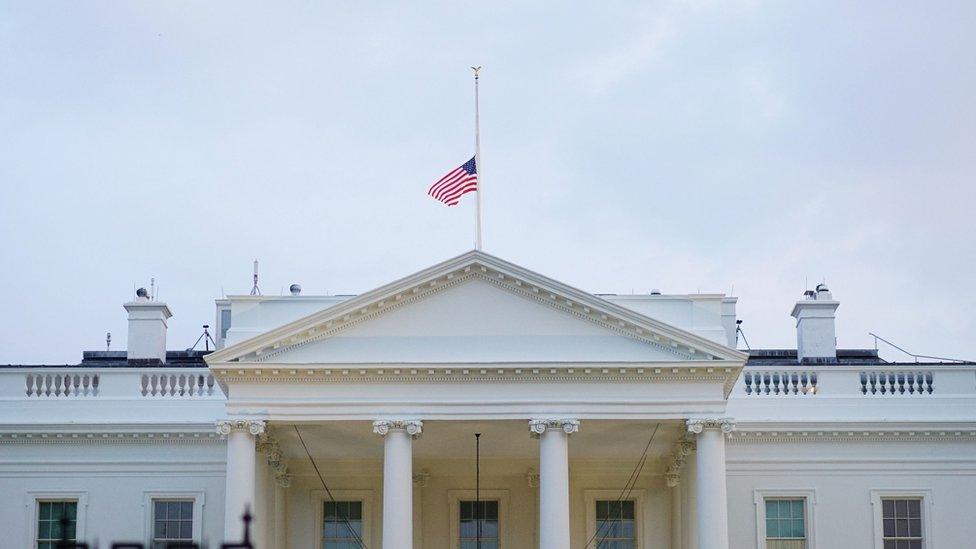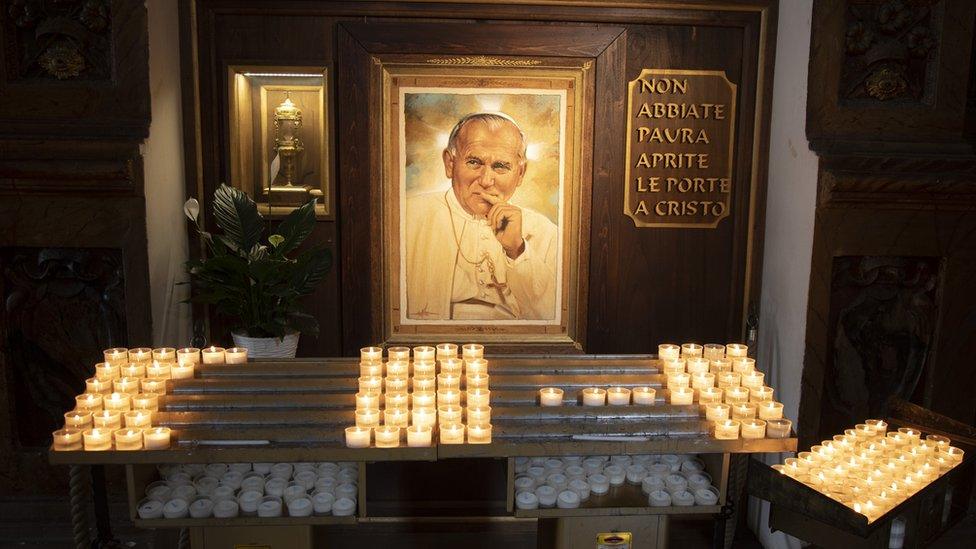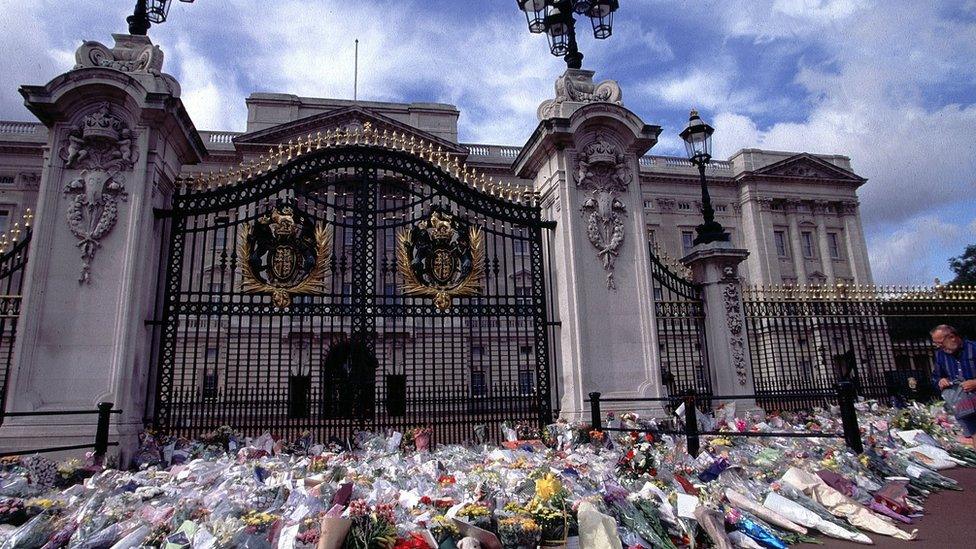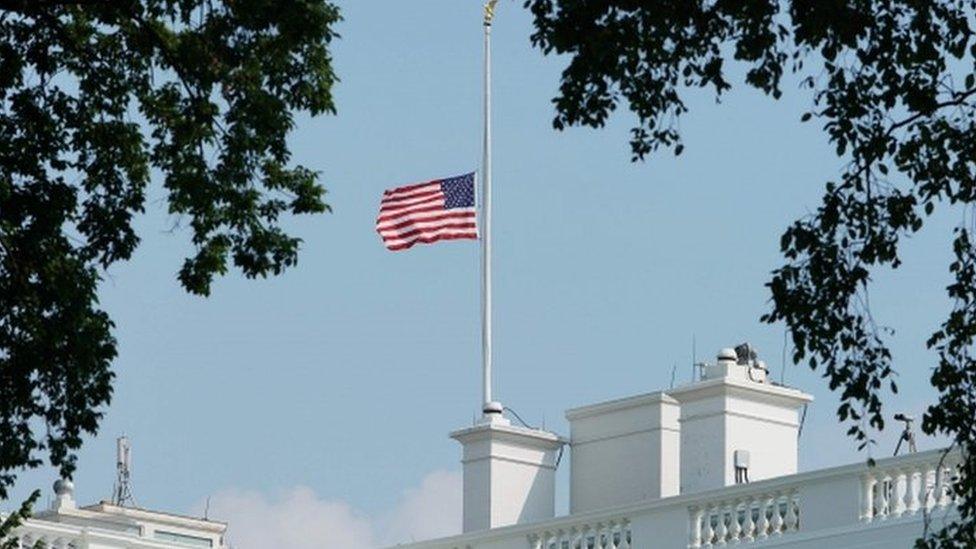John McCain death: A brief history of flag tributes and non-tributes
- Published

The US flag has been down and up and down again after the death of Senator John McCain
The White House flag has been lowered again in response to the death of Republican senator John McCain, after critics had complained about how quickly it was raised.
In most countries flags are flown at half-mast - or at half-staff as the practice is known in the US - as a sign of mourning following the death of a leader or senior politician, or in response to a major disaster or tragedy.
But the decision on whether or not to lower a flag can be fraught with controversy.
Newspaper shooting
Mr Trump has been criticised on the issue in the past.
In June, Annapolis Mayor Gavin Buckle asked the White House to fly its flag at half-mast after a gunman killed five journalists working at a newspaper in his city.
But he said his request was declined.
The following day, Mr Trump ordered all flags at public buildings, military posts, naval vessels and embassies to be lowered. The White House later said the president acted as soon as he heard of the mayor's request.

The victims, from top left: Rob Hiaasen, Rebecca Smith, Gerald Fischman; John McNamara (bottom centre), Wendi Winters (bottom right)
Soldiers and a singer
Mr Trump highlighted the issue during the presidential campaign.
In 2015, he criticised then-President Barack Obama for not lowering the flag after the killing of five soldiers at a US Navy Reserve centre in Chattanooga, Tennessee.
"This disgraceful omission is unacceptable and yet another example of our incompetent politicians," he wrote at the time. "It is a simple yet meaningful and important gesture that signifies our respect and recognition for these great soldiers who lost their lives."
Allow Facebook content?
This article contains content provided by Facebook. We ask for your permission before anything is loaded, as they may be using cookies and other technologies. You may want to read Meta’s Facebook cookie policy, external and privacy policy, external before accepting. To view this content choose ‘accept and continue’.

The White House lowered flags five days after the shooting, but not before internet rumours resurfaced criticising Mr Obama for allegedly doing so after the death of singer Whitney Houston and ignoring the killing of military personnel.

Barack Obama did not lower the flag for Whitney Houston
In reality, Mr Obama did not lower flags for the singer's death, but New Jersey's Republican Governor Chris Christie did in his state.
Saudi king
Flying a flag at half-mast following the death of the head of state is a common practice across the world.
In the UK, such tributes honour rulers of allied nations on the monarch's command.
But lowering the flag for a foreign leader can prove to be controversial, as former Prime Minister David Cameron discovered after the death of Saudi King Abdullah bin Abdulaziz in January 2015.

Mourners pray at the grave of Saudi King Abdullah bin Abdulaziz
Politicians and activists criticised the decision in view of the kingdom's human rights record. Scottish Conservative leader Ruth Davidson described the move as "a steaming pile of nonsense".
Mr Cameron later defended the "long-standing relationship" between the UK and Saudi Arabia, saying: "We don't agree with lots of things that the Saudis do. We don't agree with the way they treat people, for instance criminals.
"But when the king died, as a mark of respect, we thought it was right to show that respect."
Saudi Arabia's own mourning ceremonies are understated. Its flag is never lowered, and the late king was buried in an unmarked grave.
The Pope
France is well known for its strict adherence to secularism.
As the law which enshrined the separation of churches and the French state celebrated its 100th anniversary in 2005, a new controversy emerged.

Pope John Paul II died in 2005
When the government lowered flags after the death of Pope John Paul II - the head of a foreign state - many politicians criticised the decision, saying it came into conflict with the country's secular tradition.
The only legislation on the lowering of flags in France refers to the death of the French president. In other cases the decision is at the discretion of the president or prime minister.
France also notably flew its flags at half-mast to mark the deaths of former US President Ronald Reagan and Soviet leader Joseph Stalin.
Princess Diana
In 1997, amid the outpouring of grief unleashed across Britain by the death of Princess Diana, official buildings across London lowered their flags.
But there was one notable exception: Buckingham Palace.
Newspapers were quick to pick up on the fact, with the Sun asking on its front page "Where is our Queen? Where is her flag?"

Flowers laid in tribute to Princess Diana - but no flag over Buckingham Palace
According to royal protocol, the Royal Standard is flown whenever the Queen is present at a building and must be removed after she leaves, meaning that no flag could be flown in her absence.
The flag also represents the continuity of the monarchy and can therefore not be lowered.
In the end, a compromise was reached. Once the Queen had left for the funeral and the Royal Standard was taken down, the Union flag was flown at half-mast.
- Published28 August 2018

- Published27 August 2018